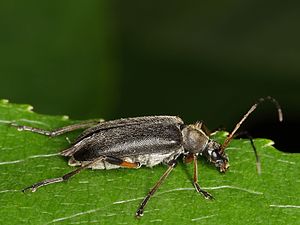Black deep-eyed buck
| Black deep-eyed buck | ||||||||||||
|---|---|---|---|---|---|---|---|---|---|---|---|---|

Black deep-eyed billybuck ( Cortodera femorata ) |
||||||||||||
| Systematics | ||||||||||||
|
||||||||||||
| Scientific name | ||||||||||||
| Cortodera femorata | ||||||||||||
| ( Fabricius , 1787) |
The Black Deep eyes Bock ( Cortodera femorata ) is a beetle from the family of longhorn beetles (Cerambycidae). The species is distributed in Northern Europe as well as in Eastern Europe and from there further east. It is one of 24 species of its genus in Europe.
features
Characteristics of the adults
The black deep-eyed billy reaches a body length of 7 to 11 millimeters. The body is typically long and has a relatively short pronotum that is clearly throat-like at the front. The elytra are stretched and hardly narrowed backwards. They are usually colored monochrome black, but can also be yellow-brown with a thin, dark wing cover seam ; then the antennae and legs are also yellow. The base of the wing covers, the forelegs, and the base of the rear thighs are yellow. The first link of the hind tarsi is significantly longer than the second and third combined. The top is densely hairy yellowish; the hairs of the elytra protrude over the base of the points behind , in which they arise.
Characteristics of the larvae
The body and head of the larvae of the genus are similar to those of the genus Acmaeops , are not clearly flattened, and the sides of the head are only slightly convex to subparallel. The antennae are short and tripartite; the second antenna element is extremely small and unsclerotized. There is only one large stemma on either side of the head capsule . The maxillae are robust and the malae do not have an obliquely pigmented band. The abdominal sclerites of the abdominal segments have no bristles and the ninth abdominal segment does not have a caudal spine at the end of the body.
distribution
The black deep-eyed billybuck is probably a Siberian fauna element and is common in southern northern Europe and in eastern Europe and from there further east. There is no evidence in Denmark , the Netherlands , Luxembourg , Liechtenstein and Belgium . In Germany and Austria the species is documented in all federal states, in Switzerland it is also common. It can be found in the lowlands and also at high altitudes.
Way of life
The black deep-eyed buck lives mainly in coniferous forests and clearcuts , both in the lowlands and at higher altitudes. The adults can be found from May to June, regionally also from April to August. They are diurnal and mainly fly on sunny days in July and August. They can be found on wood and flowering herbs. The beetles visit the flowers of various herbs and trees, including hawthorns ( Crataegus ), pines ( Pinus ) and various types of Rubus .
The animals develop mainly in fallen cones of pine ( Pinus ) and spruce ( Picea ). They live there in the cone core or in the base area of older cones. The eggs will likely be laid on the pinecones that have already fallen off. Alternatively, the development of the larvae in the fresh humus layer in the soil, which is populated by the coniferous pale spout ( Gymnopus perforans ), or in wooden fathers was described. The pupation takes place in the pin or in the ground, and the larvae are preparing for this a doll's chamber before in which they hibernate and pupate in the spring.
Systematics
The black depth Bock eyes is a separate type of longhorn beetles (Cerambycidae), where it is in the genus of low eye brackets ( Cortodera Mulsant 1862 ) within the narrow blocks classified (Lepturinae). The first scientific description comes from the entomologist Johann Christian Fabricius , who described it in 1787 as Leptura femorata . In addition to this species, the genus contains numerous other species. In addition to Leptura femorata , synonyms of the species are also Cortodera affinis Schilsky, 1892 and Leptura fusca Gmelin, 1790 nec Geoffroy, 1785 .
The name for the genus is probably derived from the Latin “ curtus ” for “short” and the Greek “ dere ” for “ neck ”, which could refer to the form of the pronotum. The epithet " femorata " comes from Latin and means "thigh".
supporting documents
- ↑ a b c d e f g h i j k l m "Species: Cortodera femorata (Fabricius, 1787) - Black deep-eyed billybuck ." In: Bernhard Klausnitzer, Ulrich Klausnitzer, Ekkehard Wachmann, Zdeněk Hromádko: Die Bockkäfer Mitteleuropas . Die Neue Brehm-Bücherei 499, Volume 2, 4th edition. VerlagsKG Wolf, Magdeburg 2018, ISBN 978-389432-864-1 ; Pp. 381-382.
- ↑ a b c "18. Genus: Cortodera Mulsant. “In: Edmund Reitter : Fauna Germanica. The beetles of the German Empire. KG Lutz, Stuttgart 1912; Pp. 13-14. ( Digitized version )
- ↑ a b Bernhard Klausnitzer, Ulrich Klausnitzer, Ekkehard Wachmann, Zdeněk Hromádko: The longhorn beetles of Central Europe . Die Neue Brehm-Bücherei 499, Volume 1, 4th edition. VerlagsKG Wolf, Magdeburg 2018, ISBN 978-389432-864-1 ; Pp. 105-107
- ↑ Cortodera femorata. Fauna Europaea, accessed June 24, 2020 .
- ^ Karl Wilhelm Harde, František Severa: Der Kosmos Käferführer. The Central European beetle. Franckh-Kosmos Verlag-GmbH & Co, Stuttgart 2000, ISBN 3-440-06959-1 ; P. 266.
- ↑ Cortodera femorata on biolib.cz; accessed on June 24, 2020.
literature
- "Species: Cortodera femorata (Fabricius, 1787) - Black deep-eyed billybuck ." In: Bernhard Klausnitzer, Ulrich Klausnitzer, Ekkehard Wachmann, Zdeněk Hromádko: The longhorn beetles of Central Europe . Die Neue Brehm-Bücherei 499, Volume 2, 4th edition. VerlagsKG Wolf, Magdeburg 2018, ISBN 978-389432-864-1 ; Pp. 381-382.

